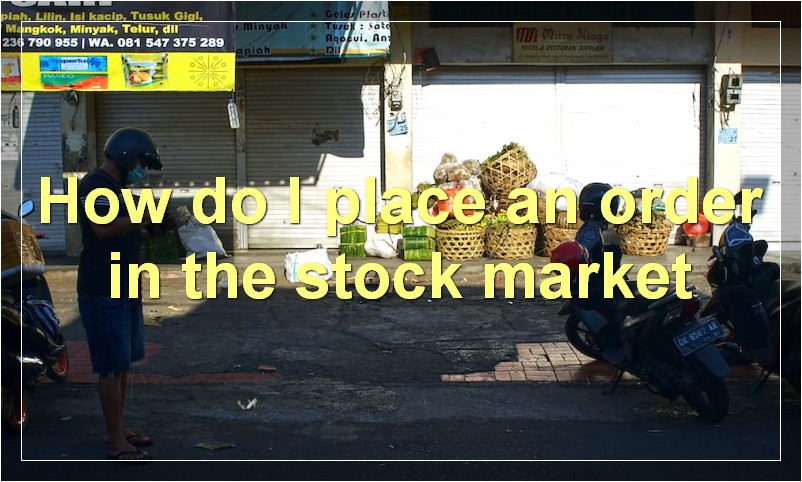If you’re new to the stock market, you may be wondering what all the different types of orders are. In this article, we’ll explain the different types of orders and how they can be used to your advantage.
What are the different types of orders in the stock market
When it comes to investing in the stock market, there are a few different types of orders that you can place. These include market orders, limit orders, stop orders, and more. Each type of order has its own set of rules and guidelines, so it’s important to know which one is right for your investment strategy.
Market Orders:
A market order is an order to buy or sell a security at the current market price. Market orders are the most basic type of order and are usually filled immediately. However, because they are filled at the current market price, you may not always get the best possible price for your shares.
Limit Orders:
A limit order is an order to buy or sell a security at a specific price. Unlike market orders, limit orders are not filled immediately. Instead, they are placed on the order book and only filled when the stock reaches your specified price. Limit orders give you more control over the price you pay (or sell for), but there is no guarantee that your order will be filled.
Stop Orders:
A stop order is an order to buy or sell a security when it reaches a certain price. Stop orders are typically used to limit losses or lock in profits on a stock that is moving in the desired direction. When the stock reaches your stop price, the stop order becomes a market order and is filled at the next available price.
There are a few other types of orders that are less common, but these are the three main types of orders that you’ll need to know about when investing in the stock market. Now that you know the basics, you can start placing orders and begin growing your portfolio!
What is a market order

Most market orders are placed electronically through an online broker and executed instantaneously at the current market price. Some brokerages allow investors to place market orders over the phone with a live broker, but this generally costs more.
A market order is an order to buy or sell a security at the best available price. Market orders are the most common type of order and are filled immediately. When you place a market order, you are instructing your broker to buy or sell shares at the best available price in the market.
Market orders are used when you want to buy or sell a security as soon as possible and are willing to accept the current market price. This type of order guarantees that your trade will be executed, but does not guarantee the execution price.
If you want to ensure that your trade is executed at a specific price, you can place a limit order. A limit order is an order to buy or sell a security at a specified price or better. Limit orders give you more control over the price at which your trade is executed, but there is no guarantee that your trade will be filled.
When placing a market order, you should be aware of the risk of slippage. Slippage occurs when the market price of a security moves away from the quoted price before your trade can be executed. Slippage is more likely to occur in fast-moving markets and can result in your trade being executed at a worse price than you had expected.
What is a limit order
A limit order is an order to buy or sell a security at a specified price or better. A buy limit order can only be executed at the limit price or lower, and a sell limit order can only be executed at the limit price or higher. Limit orders are not guaranteed to be executed.
A limit order gives the investor more control over the execution price of their trade, but there is also the risk that the order may not be executed at all if the market price never reaches the limit price. Unlike market orders, which are filled at the best available price, limit orders may only be filled if the security’s market price reaches the specified limit price.
For example, let’s say you wanted to buy shares of XYZ stock at $50 per share, but you didn’t want to pay more than that. You would place a buy limit order for XYZ stock at $50. If the shares of XYZ stock drop to $50 or below, your order will be filled and you will pay $50 per share. However, if the shares of XYZ stock never drop to $50 and remain above that price, your order will not be filled and you will not purchase any shares.
What is a stop order
A stop order, also called a stop-loss order, is an order placed with a broker to buy or sell a security when it reaches a certain price. This type of order is used to limit an investor’s loss on a security position. A stop order becomes active once the security’s price reaches the stop price and is then filled at the next available market price.
What is a stop-limit order
A stop-limit order is an order to buy or sell a security at a specified price or better after the security reaches a specified stop price. Once the stop price is reached, the stop-limit order becomes a limit order to buy or sell at the limit price or better. A stop-limit order is not guaranteed to execute.
How do I place an order in the stock market

When it comes to investing in the stock market, there are a few different ways to place an order. For example, you can place a market order, limit order, or stop order.
If you want to buy or sell shares of a stock immediately, then you would place a market order. This type of order guarantees that your trade will be executed at the best available price.
If you want to set a specific price for your trade, then you would place a limit order. This type of order allows you to name your own price for a stock and ensures that your trade will only be executed if the stock reaches that price.
Finally, if you want to set a stop-loss for your trade, then you would place a stop order. A stop order is an order to buy or sell shares of a stock once it reaches a certain price. This type of order helps you to limit your losses in case the stock price falls.
How can I cancel an order in the stock market
When it comes to the stock market, there are a lot of things that can go wrong. If you’re not careful, you can lose a lot of money very quickly. That’s why it’s important to know how to cancel an order in the stock market.
If you’ve made a mistake and want to cancel an order, the first thing you need to do is contact your broker. They’ll be able to help you cancel the order and avoid any penalties.
It’s also important to remember that you can’t always cancel an order. If the stock has already been traded, you won’t be able to cancel it. So, it’s important to be sure that you really want to sell before you place an order.
Overall, cancelling an order in the stock market isn’t too difficult. Just be sure to contact your broker and make sure that you really want to sell before you place an order.
How do I change an order in the stock market
Assuming you would like five paragraphs:
It is not difficult to change an order in the stock market. Many people believe that you need a broker to do this, but that is not the case. You can easily place an order online or over the phone. The process is simple and takes only a few minutes.
If you have never placed an order before, you may be wondering how to do it. The first step is to find the stock you want to buy or sell. You can do this by looking up the ticker symbol for the company on a financial website. Once you have found the stock, you will need to decide how many shares you want to buy or sell.
Once you have found the stock and decided how many shares you want, you will need to place your order. If you are buying stock, you will need to choose a limit or market order. A limit order means that you are willing to pay a certain price for the stock, but no more. A market order means that you are willing to pay whatever the current market price is for the stock. If you are selling stock, you will need to choose a limit or stop order. A limit order means that you are willing to sell your stock at a certain price, but no less. A stop order means that you are willing to sell your stock at whatever the current market price is.
After you have chosen the type of order, you will need to enter your information and submit your order. Your broker will then execute the trade and confirm that it has been completed. You should receive an email or notification from your broker confirming the trade. That’s it! You have now successfully placed an order in the stock market.
What happens if my order is not executed in the stock market
If your order is not executed in the stock market, you may be able to cancel the order and receive a refund. Alternatively, you may be able to negotiate with the broker to have the order executed at a later time. If your broker is unable to execute your order, you may be able to file a complaint with the securities regulator.
Why would I use a limit order in the stock market
A limit order is an order to buy or sell a security at a specified price or better. A buy limit order can only be executed at the limit price or lower, and a sell limit order can only be executed at the limit price or higher. A limit order is not guaranteed to be executed.

